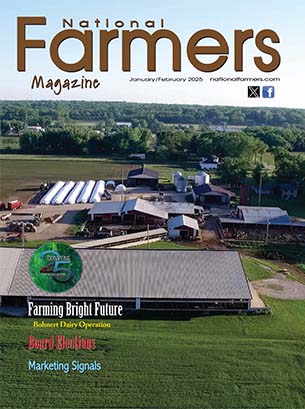Farm Partnership Recoups Losses
with National Farmers Crop Insurance
National Farmers members at Mill Creek Farms in southern Indiana clashed with the weather in 2018, and too much rain turned into lost bushels.
“It was brutal getting planting completed and battling the elements,” says Duane Hopf, a partner in the operation with his uncle and aunt, Randy and Betty Mehringer, and their son, Aaron.
The Rains Came
The operation’s concerns mainly involved the soybean crop in river bottoms. They planted soybeans about May 20 and saw them up and growing — until about June 15, when they were flooded out, Hopf said. The producers submitted a claim for replant with National Farmers Crop Insurance and replanted about July 7 in those areas.
“And that was off and going good, the crops were almost mature, and then another flood event happened about Sept. 5,” Hopf said. “It pulled that water into river bottoms and lower sloughs, and that was too late to replant, of course.” The flooding at that time of year was very unusual, with that timeframe typically bringing much dryer weather.
Flipping the bad penny to the shiny side, the farm had invested in National Farmers Crop Insurance policies tailored to the needs of their farm enterprise. For the Mehringer – Hopf partnership, it’s the recovery trifecta with National Farmers Crop Insurance — the right policies, first-rate service and a paid claim to recoup some of the revenue losses.
Hopf was pleased with the process and personal attention. The adjuster visited Mill Creek Farms again after the late-season flood event, viewed the fields and communicated with Hopf and his agent, Mike Kleaving. “Everything they should have done, they did.
“If we fast forward into harvest, those areas that are lower, the agent came out and did a pre-harvest assessment, and that was a good call. He called it unharvestable. We were able to come up with a good result with the damage levels out there,” Hopf says.
The Mill Creek Farms cropping situation includes cover crops. Knowing he would be required to destroy the unharvestable soybeans, Hopf explained to Kleaving that the plan for those areas, about 150 acres, included a cover crop.
The farm partners wanted to turn the page for the next year, spread the cover crop and still receive the compensation for the failed crop. “They gave us confidence in our plan to move forward with those acres,” Hopf says.
Regular Coverage, High-Risk Coverage
Having the right crop insurance for each plot of land in the first place, means not only good coverage, but also cost savings. The farm has some land that falls into high-risk categories and much more that does not. Separating the areas into different policies so that the high-risk cost is only for the acres that are truly high-risk, prevents higher premium charges to the farm than necessary for all the acres.
“It allows us to dial down our needs. The high risk would be contained on those 150 acres of bottom ground,” Hopf explains. ”The separate product is definitely an advantage for us as producers.”
Further, the claim was paid in about 10 days after finalizing the documents, and the paperwork process is streamlined. When the adjuster arrived at the final numbers, Hopf simply signed on his computer screen one time, taking care of about 20-25 signatures on previous screens. “So technology is certainly helping in that arena,” Hopf added.
“I think the National Farmers Crop Insurance program is really good,” Hopf says. “Mike goes above and beyond to keep me informed about programs available. I find it imperative to have that and he’s just a super personality.”










